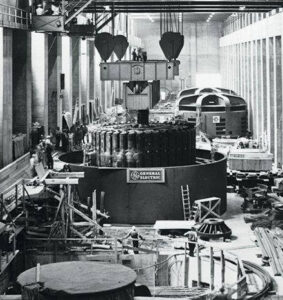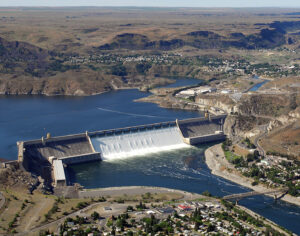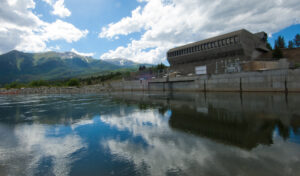The Bureau of Reclamation owns 78 hydroelectric power facilities that supply a capacity of over 15,500 megawatts (MW), of which it directly operates and maintains 53. This puts it second only to the U.S. Army Corps of Engineers in terms of its hydropower capacity. Max Spiker is a 32‑year Reclamation veteran who today serves as the agency’s senior advisor for hydropower and as an electric reliability officer. In these capacities, he coordinates the implementation of corporate partnership efforts involving Reclamation’s power functions and serves as the liaison on intergovernmental initiatives associated with hydropower delivery. In this interview, Mr. Spiker tells Hydro Leader about Reclamation’s hydro fleet and how the agency is ensuring that hydropower remains a long-term cost-competitive energy source.
Hydro Leader: Please tell us about your background and how you came to be in your current position.
Max Spiker: Today, I serve as a senior advisor of hydropower for Reclamation. I lead the oversight of the programmatic functions of Reclamation’s hydropower program—not only the policies and oversight, but also the initiatives that leadership wants to implement within the program. I work with our customers to ensure that our facilities are maintained at operational and reliable levels and that they provide the value our customers expect and deserve.
I’ve been with Reclamation for 32 years, having started with the agency during college as a supply clerk at a power facility. Eventually, I gravitated toward power plant maintenance, working as a hydroelectric mechanic at the Hoover Dam at the time of its generator upgrade program. It involved uprating the turbines to a more efficient design with greater horsepower, which also allowed the generators to be uprated to take advantage of the enhanced turbine horsepower, leading to increased energy output.
After Hoover, I ran several smaller power plant facilities as a power plant supervisor and facility manager and eventually became a power manager in Reclamation’s Upper Colorado region. It was during this time that I worked closely with the Colorado River Energy Distributors Association to implement new program-operation and maintenance protocols for the Colorado River Storage Project facility plants. After that, I became an analyst for the operations and maintenance program in the power program office in Reclamation’s Denver office. A few years later, I became the manager of the power resources office, and in 2016, I was named senior advisor for hydropower, which is the position I hold today. It’s been a wonderful opportunity, and while it has always involved a lot of work, it seems easy when you are working on a good program that you truly believe in.

That’s not to say that we don’t face challenges. Many of our facilities have aging infrastructure, and most of our plants are well over 50 years old. Beyond the operations and maintenance costs that aging infrastructure poses, we are seeing additional costs that contribute to rate increases. We are in the era of low-cost natural gas as well as emerging nonhydro renewable energy sources. While nonhydro renewables are still in their infancy, their infrastructure costs have gradually become more affordable, allowing them to offer more competitive rates. Our rates are escalating or staying relatively flat at the very time that theirs are decreasing, causing rate pressures in certain locations. That’s been an issue that we’ve been working with our customers to resolve over the last few years, and we will continue to do so.
Hydro Leader: Would you give us an overview of Reclamation’s hydropower program?
Max Spiker: The Bureau of Reclamation was established in 1902 to reclaim the arid West by providing the resources that would allow it to be populated and to thrive. The cornerstone of Reclamation’s mission was water supply, in the beginning primarily for agriculture, but today for municipal and industrial uses as well. That water storage capacity also provided the opportunity for storing energy through hydropower. For the first half of the 20th century, great swaths of rural America, particularly in the West, did not have ready access to electricity or water. Federal hydropower facilities played a dramatic role in changing all that. Not only did they provide water for agriculture, they helped develop towns and cities and enabled the industrialization that followed. Today, you could say that Reclamation has four major areas of focus: water supply, power production, flood control, and recreation.
On the power side, our facilities generate power for our own on-project use and for others. Figures vary by project and time of year, but over an average year, we use about 20 percent of our power capacity for internal project-use operations, such as pumping water uphill to an elevation from which it can travel by gravity to the customers it’s been designated for. The other 80 percent of our capacity is what we refer to as surplus power. Surplus power is marketed by the U.S. Department of Energy’s Power Marketing Administrations at cost-based rates, with preference given to municipalities, public corporations, cooperatives, and other nonprofit organizations. This surplus power provides a primary source of revenue for Reclamation project repayment, initial construction, operations and maintenance, and replacement costs.
Hydro Leader: Please tell us about Reclamation’s federal hydropower fleet and the ages and sizes of the installations that form part of it.
Max Spiker: Reclamation owns 78 hydroelectric power facilities with a total of over 15,500 MW of capacity. Of the 78 facilities it owns, Reclamation directly operates and maintains 53, making up the bulk of that capacity—over 14,700 MW. We refer to the 53 facilities directly operated and maintained by Reclamation staff as reserved works. The remaining 25 facilities are generally referred to as transferred works, since facility operations and maintenance responsibilities have been transferred to a nonfederal entity through a formal agreement.
To give you a little perspective, our reserved facilities generate about 40 million megawatt-hours annually and constitute about 15 percent of hydroelectric power capacity and generation in the United States. In terms of capacity and generation, we are second only to the Army Corps, which oversees facilities that account for nearly 25 percent of the nation’s hydroelectric power capacity. Since the 1980s, we’ve done a lot to upgrade our facilities, which, as I mentioned, are generally decades old. It is a constant effort.
Just in the past 20 years, we’ve replaced 62 turbines, which has improved our overall efficiency by about 4 percent. We’ve also completed 24 generator uprates, delivering a little over 200 MW of incremental capacity over what was originally installed.
Hydro Leader: How many employees does the hydro program have?
Max Spiker: Reclamation has a little over 5,000 employees in total; of those, approximately 1,300 work directly in our hydropower-related facilities.

Hydro Leader: Would you describe the nonfederal hydroelectric power development that is occurring on Reclamation-owned projects?
Max Spiker: There are two avenues to develop nonfederal power plants on Reclamation projects. One is the Federal Energy Regulatory Commission (FERC) licensing process; the other is the Reclamation process known as Lease of Power Privilege (LOPP). Which process is appropriate for a given development depends on the purpose for which the underlying Reclamation project feature was originally authorized. If the original project feature was authorized for a nonpower purpose, nonfederal development would be permitted through the FERC licensing process; if the project feature was authorized for federal power development, nonfederal development would be permitted through the LOPP process. Right now, there are 65 nonfederal power facilities with over 500 MW of capacity in operation on Reclamation projects. There are also 26 conventional nonfederal projects in active development on Reclamation projects.
Hydro Leader: What role does Reclamation’s hydropower program play in the administration’s domestic energy strategy and supporting initiatives?
Max Spiker: Reclamation’s hydropower programs support a number of the administration’s initiatives, such as Executive Order 13783 on Promoting Energy Independence and Economic Growth. They also support the president’s agenda for the U.S. Department of the Interior, which is to ensure energy and economic security for the United States, as highlighted in Interior’s strategic plan for fiscal years 2018–2022. In that plan, Interior has identified incremental hydropower capability as a key performance indicator. Our goals for the mission area are focused on increasing generating capability by an average of 10 MW per year for the duration of the strategic plan. Over the last 3 years, we have far surpassed that figure, realizing a 53 MW gain.
Hydro Leader: Has that all occurred through enhanced efficiencies and upgrades?
Max Spiker: Yes, as well as some nonfederal development on Reclamation’s nonpower dams and facilities.
Hydro Leader: What is Reclamation doing to ensure that hydropower remains a long-term cost-competitive energy source?
Max Spiker: Reclamation’s hydropower generation is marketed at a cost-base rate that is inclusive of recoverable and reimbursable project costs allocated to the hydropower beneficiaries. Our surplus power rates have obviously risen throughout our history, but this has been the case in a more pronounced manner in recent years, as we continue to invest in facilities and as wholesale market rates in some locales have decreased due to the emergence of renewable energy sources and inexpensive natural gas generation. Some of our power customers have expressed concerns over our rates. Another difficulty is posed by the fact that at certain points of any day, you can buy an energy mix that has an overall lower cost than what our contract is priced at.

In response, Reclamation has implemented a power initiative to ensure that its hydropower remains a long-term cost-competitive energy resource that will secure a committed customer base. The power initiative focuses on identifying opportunities to curb or stabilize hydropower program costs and to achieve operational and administrative efficiencies. It involves the development and deployment of technological innovation as well as collaborations with federal and nonfederal industrial partners to conduct hydropower program benchmarking to ensure that our performance is in line with that of the industrial hydropower sector and that we are using best practices to achieve overall operational efficiencies.
Hydro Leader: What are some of the innovative tools that Reclamation uses in the operations of its facilities?
Max Spiker: One example is a partnership we undertook with the Army Corps to develop a corporate hydropower optimization system called HydrOS, or the Hydropower Optimization System. HydrOS is a flexible, standalone computer package featuring modern hardware and algorithms configurable to all Reclamation hydropower plants. HydrOS recommends an optimal way to operate units to maximize facility efficiency and generation, given water or power targets entered by the facility operator. In addition to maximizing facility generation, HydrOS delivers water conservation benefits, as less water is required to meet power targets. We have deployed it at most Reclamation control centers and are working on the remaining installations.
Just by changing how we operate our individual generators, the HydrOS system has resulted in efficiency gains of 1.75 percent on average. In some facilities, we’ve seen operational efficiencies of over 10 percent. While we are squeezing out efficiencies, it is also gratifying to know that the vast majority of our facilities were already being operated at highly efficient levels.
We are also looking into participating in the Hydropower Research Institute, which is digitally enhancing the hydropower industry’s availability, flexibility, and adaptability in order to ensure that it remains a cornerstone of the electric grid. It’s focused on aggregating and standardizing hydropower operational data from across the industry and using those data to do predictive analytics to understand and learn from how a given fleet is performing. The benefit of this will vary among hydro asset owners, manufacturers, and researchers, but will ultimately result in a decrease in operational costs and forced outages, stronger research and development efforts, and better service delivery to customers in our changing marketplace. It is important to take the time to collect and analyze data from our own systems to inform our future decisionmaking and our responses to outages or other operational issues.
Hydro Leader: What is your message to those who depend on Reclamation projects for power?
Max Spiker: I think it important for them to understand that we are that cornerstone I alluded to. Do we have challenges? Yes. Are we taking steps to overcome those and remain the partner of strength that we have always been? Yes. Can they rely on us to continue identifying efficiencies and other innovations that will ensure we can offer them affordable and reliable services? Yes. Reclamation was formed, and its facilities were built, to respond to a major national objective; we did that on a massively successful scale. Reclamation will never let go of the spirt of innovation and accomplishment, and that is why I’m confident that we will be able to evolve in ways that ensure we will always be of great value to our customers and the nation.
Max Spiker is a senior advisor for hydropower and electric reliability officer at the Bureau of Reclamation. For more about the Bureau of Reclamation, visit www.usbr.gov.

